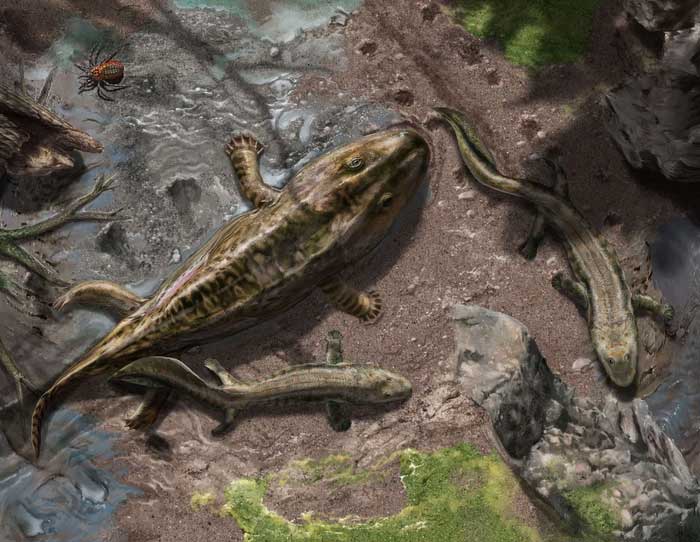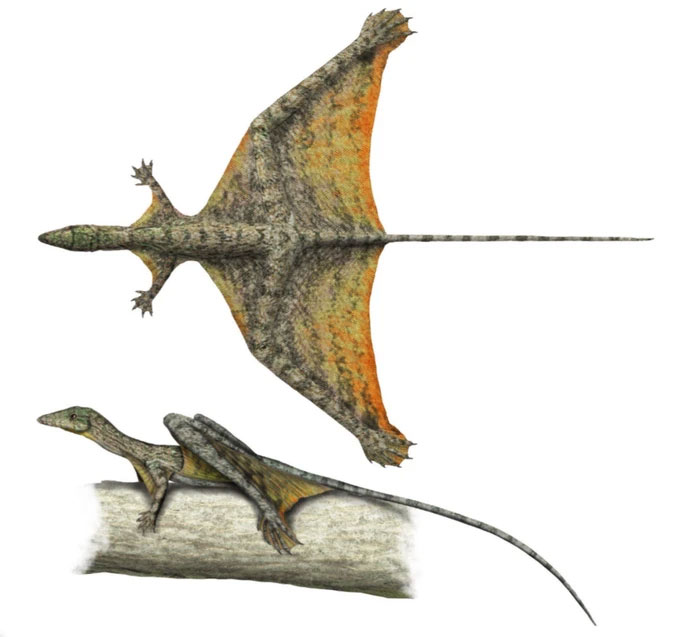What strange prehistoric creatures have humans discovered?
Millennia ago, before history was written, these strange creatures roamed the Earth .
Top 11 strange prehistoric creatures discovered by humans
The most famous of all the prehistoric creatures ever discovered by man are the dinosaurs. Countless movies have been made about these amazing reptiles. But in different eras of prehistory, our world has been home to many other strange and wonderful creatures.
Ichthyostega

This creature has the head and tail of a fish.
Living in the late Devonian period, Ichthyostega was one of the earliest amphibians on the planet. It had the head and tail of a fish, and needed to return to the water to reproduce.
The distinguishing feature of Ichthyostega from lobe-finned fish is its limbs. In Ichthyostega, the fins are joined together, and there are leg bones and toes. The feet of Ichthyostega are quite strange by modern standards, with up to eight toes per foot.
Sharovipteryx

Sharovipteryx lived in the Early Triassic period more than 240 million years ago.
Scientists believe that Sharovipteryx was a relative of the winged reptiles known as pterosaurs. It is not classified as a true pterosaur itself, and lived in the Early Triassic period some 240 million years ago.
The fossils of this creature were unearthed in the Madygen Formation in Kyrgyzstan, Central Asia. It was only about 30 centimeters long. This strange creature had four appendages that appeared to have thin flaps of skin that resembled wings. The front two legs were quite short, while the hind legs were much longer.
Some theorize that this body structure allowed Sharovipteryx to jump with ease. Paleontologists believe its mode of locomotion was more like gliding than actual flight – perhaps it moved like modern flying squirrels, hopping and gliding through the air to reach other tree branches.
Check out the "strange" animals that once dominated the Earth

Longisquama lived in forests that covered the supercontinent Pangaea during the Triassic period.
The creature is classified as a diapsid - a primitive reptile subclass that would evolve into the most important reptile subclass on our planet. Creatures in this class originally appeared as a small group of climbing reptiles. Longisquama lived in the forests that covered the supercontinent Pangaea during the Triassic period.
The most striking feature of this strange creature is a double row of long scale-like structures running down its back, in 6 to 8 pairs. These pairs of scales would have grown out of each pair of ribs. The scales had a hollow vein in the middle, much like a bird's feathers. But unlike feathers, Longisquama's scales appear to be made of flat plates rather than actual feathers.
Stagonolepis

This is again the most poisonous of the early crocodiles.
The Triassic Earth was home to many species of prehistoric crocodiles, and Stagonolepis was one of them. However, it was unique among early crocodiles and probably very special when compared to modern crocodiles.
The crocodiles we know of are all carnivores, but Stagonolepis was different, it was a herbivore and it was one of the most common species in the late Triassic period.
This strange creature has a very small head compared to the size of its body (only about 10% of its total body length). What is special is that the front of its jaw has no teeth, instead there is a beak-like structure to aid in digging along with two front legs to search for food.
Casea

This prehistoric creature had a large chest and was capable of growing up to 120cm in length.
Casea were a group of primitive reptiles, none of which are alive today. These creatures were massive, pig-like creatures, but had tiny heads, protruding upper jaws with sharp teeth, but no teeth in the lower jaws. This gave Casea a rather silly appearance. These prehistoric creatures had large chests and could grow up to 120 cm long. These strange creatures lived mainly during the late Permian period.
Are bird ancestors dinosaurs?

This is believed to be the ancestral bird.
The creature's Greek name is 'the first bird' , and it is believed to have existed during the Jurassic period. A fossil feather of this species was discovered in 1861 in Solnhofen, Germany, where high-quality lime deposits had been mined for over a century.
Panic with the most bizarre prehistoric creatures

This dinosaur is quite a mystery to paleontologists.
This dinosaur is a bit of a mystery to paleontologists as the only known evidence of its existence is a handful of fossilised remains, consisting of two forelimbs and a few vertebrae. The fossilised remains were found on July 9, 1965 in Mongolia and were named Deinocheirus which translates to 'terrible hand'.
Dimorphodon

These creatures are said to have excellent eyesight.
Its name means 'two-form tooth', which is a result of having two distinct types of teeth in its jaws. These creatures are said to have had excellent eyesight and incredibly sharp claws for hunting fish, squid or lizards.
Epidendrosaurus

This was the first reptile to be closer to birds than to dinosaurs.
Although Archaopteryx is credited as the 'first bird', Epidendrosaurus, or 'tree lizard', was the first reptile that was closer to birds than dinosaurs. It was about 6 inches long and used its long arms and clawed hands to pry insects out of tree bark.
Panic with the most bizarre prehistoric creatures

A small feathered dinosaur that lived in the Inner Mongolia region of China, Epidexipteryx is the earliest known representative of feathered dinosaurs in the fossil record.
Roll call of giant extinct monsters on Earth

This is one of the largest arthropods ever discovered.
This extinct sea scorpion was estimated to be around 2.5 metres long, making it one of the largest arthropods ever discovered. Despite its nickname, the 'sea scorpion', it is thought to have lived in freshwater lakes and rivers in what is now Germany.
- The corpse of a monster that lived in prehistoric times washed away the American coast
- Discovered a strange mushroom creature off Australia
- 'Strange' creatures discovered in 2019
- Panic with the most bizarre shapes of prehistoric times
- Discover 4 strange sea creatures with human-like teeth
- Discovered the origin of the monster Tully 300 million years ago
- Detecting concussions about 20 species of strange creatures in Antarctica
- Discovering strange sea creatures suspected of being aliens in America
- Evidence found humans ate snakes 15,000 years ago
- Monsters covered with black thorns washed up on the river bank in England
- Exposed strange creatures weighing 1 ton, clawed dagger, tapir face
- Newly discovered insects
 Discovered an ancient centipede fossil 99 million years old
Discovered an ancient centipede fossil 99 million years old Discovered bat-like dinosaurs in China
Discovered bat-like dinosaurs in China Discovered a 200-year-old bronze cannon of the coast
Discovered a 200-year-old bronze cannon of the coast Discover 305 million-year-old spider fossils
Discover 305 million-year-old spider fossils